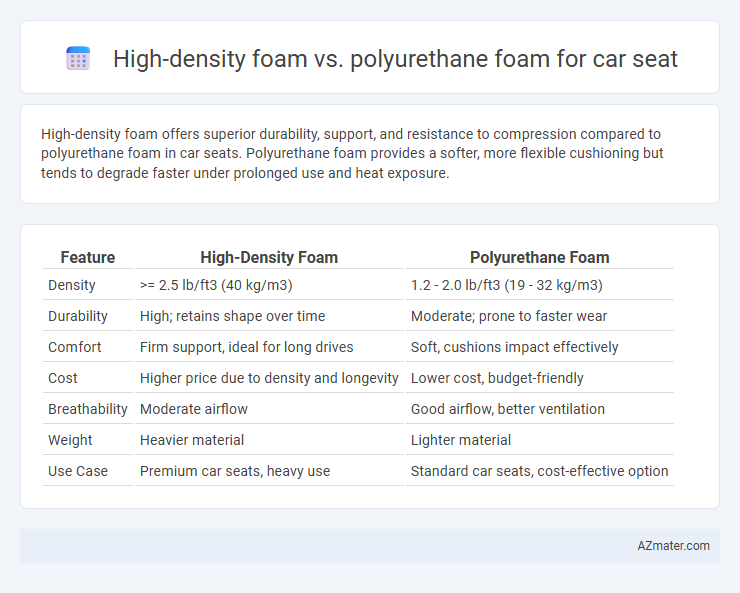High-density foam offers superior durability, support, and resistance to compression compared to polyurethane foam in car seats. Polyurethane foam provides a softer, more flexible cushioning but tends to degrade faster under prolonged use and heat exposure.
Table of Comparison
| Feature | High-Density Foam | Polyurethane Foam |
|---|---|---|
| Density | >= 2.5 lb/ft3 (40 kg/m3) | 1.2 - 2.0 lb/ft3 (19 - 32 kg/m3) |
| Durability | High; retains shape over time | Moderate; prone to faster wear |
| Comfort | Firm support, ideal for long drives | Soft, cushions impact effectively |
| Cost | Higher price due to density and longevity | Lower cost, budget-friendly |
| Breathability | Moderate airflow | Good airflow, better ventilation |
| Weight | Heavier material | Lighter material |
| Use Case | Premium car seats, heavy use | Standard car seats, cost-effective option |
Introduction: The Importance of Car Seat Foam Selection
High-density foam and polyurethane foam are critical components influencing car seat comfort, durability, and safety. High-density foam offers superior support and longevity, making it ideal for maintaining seat shape and providing consistent cushioning during extended use. Polyurethane foam, while more flexible and cost-effective, tends to compress quicker, affecting comfort and structural integrity over time.
What is High-Density Foam?
High-density foam in car seats is a type of polyurethane foam characterized by a higher mass per cubic foot, typically exceeding 2.5 pounds per cubic foot, which provides enhanced durability, support, and comfort. This foam offers superior resistance to compression and deformation, making it ideal for long-term use in automotive seating where maintaining shape and resilience is crucial. Compared to standard polyurethane foam, high-density foam delivers improved load distribution and fatigue resistance, contributing to better driver and passenger comfort on extended journeys.
What is Polyurethane Foam?
Polyurethane foam is a versatile, lightweight material commonly used in car seats for its cushioning and shock-absorbing properties. This foam type offers excellent durability and flexibility, adapting to the contours of the body to enhance comfort during long drives. Its open-cell structure allows for breathability, preventing heat buildup and maintaining a cooler seating surface compared to high-density foam.
Construction and Material Differences
High-density foam for car seats is composed of tightly packed polyurethane cells, providing superior durability and support by maintaining shape under prolonged pressure. Polyurethane foam, often lower in density, contains larger, less compact cells resulting in softer cushioning but reduced structural resilience. The construction of high-density foam involves a higher concentration of polymer chains, enhancing its load-bearing capacity compared to standard polyurethane foam typically used for comfort rather than longevity.
Comfort and Support: Comparing Seat Experience
High-density foam offers superior support and durability for car seats, maintaining its shape and firmness over extended use while providing consistent comfort during long drives. Polyurethane foam is softer and more flexible, enhancing initial comfort but may compress faster, leading to reduced support and increased fatigue. Choosing between high-density foam and polyurethane foam depends on prioritizing long-lasting support versus a softer, more cushioned seat experience.
Durability and Longevity
High-density foam offers superior durability compared to standard polyurethane foam due to its increased cell structure density, which enhances resistance to compression and wear over time. Polyurethane foam, while more affordable and flexible, tends to degrade faster under constant pressure and exposure to heat, making it less ideal for long-term car seat use. Investing in high-density foam ensures sustained comfort and structural integrity, extending the seat's lifespan significantly in automotive applications.
Cost Comparison: High-Density vs Polyurethane Foam
High-density foam typically costs more upfront than standard polyurethane foam due to its superior durability and support properties, making it a preferred choice for premium car seats. Polyurethane foam, while less expensive, tends to compress and deteriorate faster, leading to potential replacement costs over time. Evaluating long-term investment, high-density foam offers better value despite higher initial expenses due to its extended lifespan and comfort retention.
Impact on Car Safety and Ergonomics
High-density foam provides superior impact absorption and structural support, enhancing car safety by maintaining seat integrity during collisions. Polyurethane foam offers excellent cushioning but may compress faster, potentially reducing ergonomic support over time. Choosing high-density foam ensures long-lasting comfort and better protection for drivers and passengers in automotive seating.
Maintenance and Care Considerations
High-density foam offers superior durability and resistance to deformation, requiring less frequent reshaping and maintaining comfort over time, while polyurethane foam tends to compress faster and may need regular fluffing or replacement. Maintenance of high-density foam involves simple cleaning with mild soap and water, as its dense structure resists moisture absorption, whereas polyurethane foam is more prone to water damage and can develop odors if not dried properly. Proper ventilation and avoiding prolonged exposure to heat are crucial for both foam types to prevent degradation and extend the lifespan of car seat cushions.
Which Foam is Best for Your Car Seats?
High-density foam offers superior durability and support for car seats, maintaining its shape and comfort over time, making it ideal for long drives and daily use. Polyurethane foam provides a softer, more cushioned feel but tends to compress faster, leading to reduced comfort and support after extended use. Choosing high-density foam ensures better resilience and ergonomic support, enhancing overall driving comfort and seat longevity.

Infographic: High-density foam vs Polyurethane foam for Car seat
 azmater.com
azmater.com